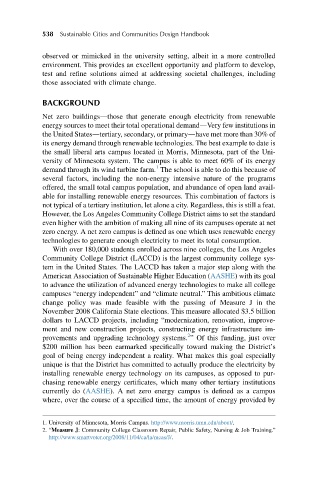Page 569 - Sustainable Cities and Communities Design Handbook
P. 569
538 Sustainable Cities and Communities Design Handbook
observed or mimicked in the university setting, albeit in a more controlled
environment. This provides an excellent opportunity and platform to develop,
test and refine solutions aimed at addressing societal challenges, including
those associated with climate change.
BACKGROUND
Net zero buildingsdthose that generate enough electricity from renewable
energy sources to meet their total operational demanddVery few institutions in
the United Statesdtertiary, secondary, or primarydhave met more than 30% of
its energy demand through renewable technologies. The best example to date is
the small liberal arts campus located in Morris, Minnesota, part of the Uni-
versity of Minnesota system. The campus is able to meet 60% of its energy
1
demand through its wind turbine farm. The school is able to do this because of
several factors, including the non-energy intensive nature of the programs
offered, the small total campus population, and abundance of open land avail-
able for installing renewable energy resources. This combination of factors is
not typical of a tertiary institution, let alone a city. Regardless, this is still a feat.
However, the Los Angeles Community College District aims to set the standard
even higher with the ambition of making all nine of its campuses operate at net
zero energy. A net zero campus is defined as one which uses renewable energy
technologies to generate enough electricity to meet its total consumption.
With over 180,000 students enrolled across nine colleges, the Los Angeles
Community College District (LACCD) is the largest community college sys-
tem in the United States. The LACCD has taken a major step along with the
American Association of Sustainable Higher Education (AASHE) with its goal
to advance the utilization of advanced energy technologies to make all college
campuses “energy independent” and “climate neutral.” This ambitious climate
change policy was made feasible with the passing of Measure J in the
November 2008 California State elections. This measure allocated $3.5 billion
dollars to LACCD projects, including “modernization, renovation, improve-
ment and new construction projects, constructing energy infrastructure im-
2
provements and upgrading technology systems. ” Of this funding, just over
$200 million has been earmarked specifically toward making the District’s
goal of being energy independent a reality. What makes this goal especially
unique is that the District has committed to actually produce the electricity by
installing renewable energy technology on its campuses, as opposed to pur-
chasing renewable energy certificates, which many other tertiary institutions
currently do (AASHE). A net zero energy campus is defined as a campus
where, over the course of a specified time, the amount of energy provided by
1. University of Minnesota, Morris Campus. http://www.morris.umn.edu/about/.
2. “Measure J: Community College Classroom Repair, Public Safety, Nursing & Job Training.”
http://www.smartvoter.org/2008/11/04/ca/la/meas/J/.

